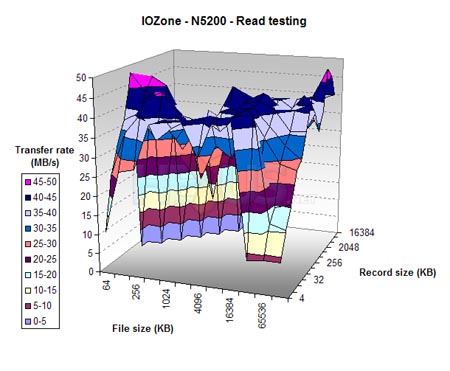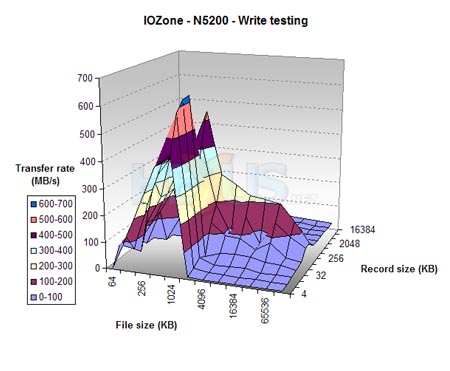Performance
To test the Thecus N5200 we setup a folder and mapped to it via a PC. The computer was running an AMD Opteron 146 at 2.0GHz, with 2GiB (4x512MiB) RAM, on an ASUS A8N SLI Deluxe. The Marvell 1Gbps network interface was used. The N5200 contained five Seagate Barracuda 7200.10 SATA 3Gbps 750GB hard drives with 16MB cache, configured into a single RAID-5 array, with the default 64KB stripe size. We feel most users will opt for this RAID type, which is why we tested with it.
Our first test uses IOZone 3.259. It's a test of the filesystem as a whole, so includes CPU, network and disk caching. We tested read and writes to the N5200 using file sizes of 4KB through to 128MB, with record (i.e. transfer) sizes of between 4KB and 16MB. The resultant surface graph shows us a number of performance aspects, not just those of the N5200 but of the test system's OS too. However, we can still pick out any places where the N5200's performance is the main influence.
Let's start with read speeds.
We don't have any IOZone readings for the Thecus N4100, but we do for the N2100 NAS and N2050 DAS appliances. We found the N2100 had performance not all that dissimilar from the N4100. So, where we once had a puny 6-8MB/s from Thecus' NAS products, we can now get 40-45MB/s. That's more like it; it even makes it worth having Gigabit ethernet. It's still got a little way to go to be as quick as a DAS solution, but immediately we're happier to see much better figures.
Cache really comes into play here, so no, the N5200 cannot be written to at a 700 megabytes per second. Get out into the blue area and transfer rates level off at about 25-30MB/s once the caches are saturated.
So, IOZone has shown us significant, no, dramatic performance improvements from Thecus' hardware.
To check up some more, we fired up Filezilla to FTP some data to and from the server. Given it's not quite as scientific, we're not going to graph the results, but figures did correlate with those provided by IOZone. We also ran IOMeter 2004.07.30 on the drive map, with the following configuration:
| Option/Test | Configuration |
|---|---|
| Outstanding I/Os | 10 |
| Individual test run time | 30 seconds |
| Read test access spec | 1MB transfers 100% sequential 100% read |
| Write test access spec | 1MB transfers 100% sequential 100% write |
| General usage access spec | 64KB transfers 50% sequential, 50% random 33% write, 67% read |
'General usage' isn't that descriptive a term for the last access specification. Instead of sustained transfer rates being tested, like the first two specs, it combines more randomised reading and writing, in an attempt to simulate something more like a real-world scenario, although the reality is it's still as synthetic a benchmark as the other two.
Seeing as we haven't run these particular tests on any other NAS box, we'll present the results in a table:
| Access spec | Read MB/s | Write MB/s | Avg. response time (ms) |
|---|---|---|---|
| Read | 49.6 | 201.4 | |
| Write | 37.7 | 264.6 | |
| General | 14.4 | 7.2 | 28.5 |
It's gratifying to see decent read and write speeds again, showing that the increased performance isn't just isolated to our IOZone testing. Note that the 'General' test uses much smaller transfer sizes, resulting in the greatly reduced response time.
So, if you were to ask us if the N5200 was fast, we'd say yes. Fast enough for an SME? Yes, we reckon so. Fast enough for one serious digital home freak? Indeed.
Props to Thecus for switching to the Celeron M processor and giving its NAS the performance boost it so desperately needed.











